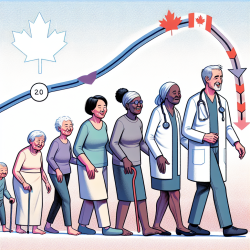Introduction
Compulsive behaviors are a complex phenomenon that manifest across various disorders, including obsessive-compulsive disorder (OCD), addictions, and binge eating. A recent study, "Transdiagnostic phenotypes of compulsive behavior and associations with psychological, cognitive, and neurobiological affective processing," offers groundbreaking insights into understanding these behaviors. This blog post will explore how practitioners can leverage these insights to enhance therapy outcomes, particularly in the context of online therapy services like those provided by TinyEYE.
Understanding the Study
The study utilized data-driven statistical modeling to identify distinct subtypes of compulsivity based on psychological, cognitive, and neurobiological markers. The researchers identified three subtypes: "Compulsive Non-Avoidant," "Compulsive Reactive," and "Compulsive Stressed." Each subtype exhibited unique characteristics and was validated through measures of mood, intolerance of uncertainty, and urgency. Notably, these subtypes were linked to distinct patterns of amygdala-based resting-state functional connectivity, underscoring the role of emotion-related brain networks in compulsive behavior.
Implications for Practitioners
Practitioners can draw several actionable insights from this study:
- Personalized Interventions: Understanding the distinct subtypes of compulsivity allows practitioners to tailor interventions to the specific needs of each subtype. For instance, individuals classified under the "Compulsive Stressed" subtype may benefit from interventions focusing on stress management and adaptive emotion regulation strategies.
- Focus on Affective Processing: The study highlights the significance of affective processing in compulsive behaviors. Practitioners should consider incorporating strategies that address affective dysregulation, such as cognitive-behavioral therapy techniques that focus on emotion regulation and coping mechanisms.
- Utilizing Neurobiological Insights: The linkage of compulsivity subtypes to neurobiological patterns suggests that interventions could be enhanced by considering neurobiological assessments. Functional MRI and other neuroimaging tools can offer valuable insights into the brain networks involved in compulsive behaviors, aiding in the development of more effective therapeutic strategies.
Encouraging Further Research
While the study provides a robust framework for understanding compulsive behaviors, it also opens avenues for further research. Practitioners are encouraged to engage in research that explores:
- Longitudinal Studies: Investigating how these subtypes evolve over time can provide deeper insights into the progression of compulsive behaviors and the long-term efficacy of tailored interventions.
- Broader Sample Sizes: Replicating the study with larger and more diverse populations can enhance the generalizability of the findings and validate the stability of the identified subtypes.
- Integration of "Cold" Cognitive Processes: Future research should explore the role of non-affective cognitive processes, such as impulsivity, in compulsive behaviors to develop a more comprehensive understanding of these phenomena.
Conclusion
The insights from this study provide a valuable framework for enhancing therapeutic outcomes for individuals with compulsive behaviors. By adopting data-driven approaches and focusing on personalized, neurobiologically informed interventions, practitioners can significantly improve the efficacy of online therapy services. For those interested in delving deeper into the research, I encourage you to read the original study: Transdiagnostic phenotypes of compulsive behavior and associations with psychological, cognitive, and neurobiological affective processing.










